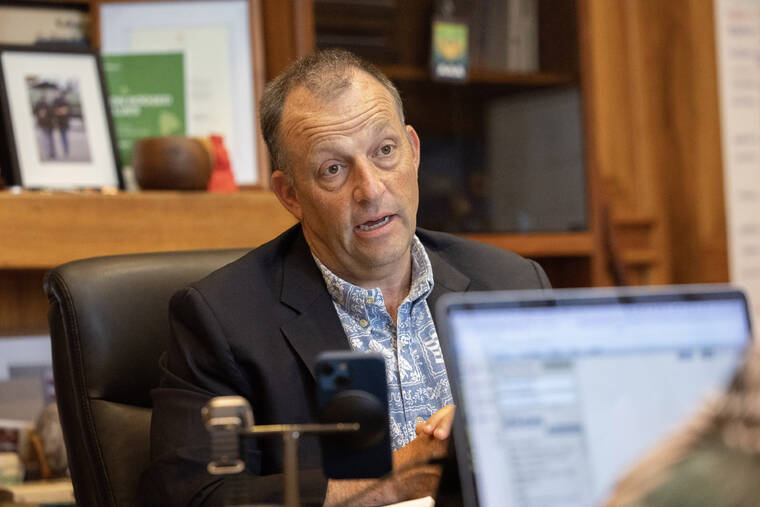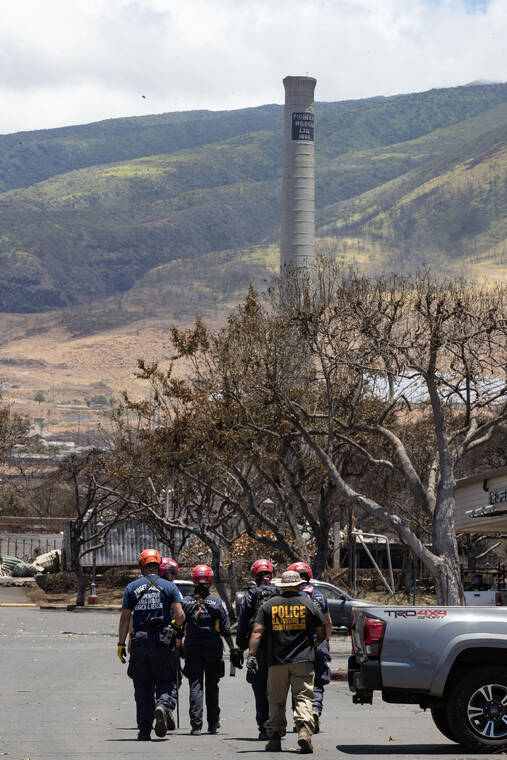Gov. Green sees hope, progress since deadly Lahaina wildfires
As Maui prepares to mark the one-year anniversary of the deadly Aug. 8 wildfires, Gov. Josh Green worries about the collective stress on the people of West Maui who continue to struggle emotionally and financially.
“The first anniversary is the hardest,” Green said in an interview in his fifth-floor office in the state Capitol, where a white board tracks data documenting what’s happened over the last year since the nation’s deadliest wildfire in a century.
ADVERTISING
In all, 102 people died in the wind-whipped Lahaina inferno and two more are believed to be missing. Thousands were forced to flee, many jumping into the ocean as the only escape, with traffic clogged along the main arteries of the historic town and hydrants running dry as firefighters struggled to douse the ferocious flames amid the collapse of the water system.
The cause of the Lahaina wildfire, and a separate blaze that same day in Upcountry Maui that claimed almost two dozen homes, has not been determined. But in the immediate aftermath, lawsuits claimed powerful winds from a passing storm toppled power lines that ignited sparks in dry brush that fueled the flames.
Investigations were launched into how state, county and emergency management agencies responded to the unfolding disasters. About 3,500 homes, in addition to businesses, schools and other properties were damaged or destroyed in the catastrophe that forced thousands into shelters.
But the numbers on a white board cannot measure the emotional toll on survivors.
“There’s a lot of despair,” Green said. “That despair is not lost on me.”
The first 51 weeks after the fires were about “survival,” the governor said. The next year will focus on “rapid rebuilding,” with priority given to the 561 owner-occupants who want to rebuild in the burn zone.
“I think there’s going to be a ton of construction,” he said.
Physical progress has moved faster than original pessimistic projections, including from other governors he met with last month in Utah at the National Governors Association Summer Meeting.
“The other governors said to expect long, long delays,” Green said. “And I just rejected that.”
Instead, 1,313 of 1,478 residential lots — over 90% — have now been cleared of fire-related debris.
A historic settlement announced Friday worth $4.037 billion would resolve about 450 lawsuits filed by individuals, businesses and insurance companies in state and federal courts for the fires in Lahaina and Upcountry Maui.
The seven defendants in the global settlement agreement are the state, Maui County, Hawaiian Electric, Kamehameha Schools, West Maui Land Co., Hawaiian Telcom and Spectrum/Charter Communications.
Hawaiian Electric said its portion of the settlement totals $1.99 billion, including the $75 million it put into the One ‘Ohana Fund to compensate victims. The state, Maui County and other defendants have not disclosed their respective shares.
The settlement awaits court approval.
The state has contributed $65 million to the One ‘Ohana Fund that will pay $1.5 million to 70 families who lost loved ones in the fires and lesser amounts to people who were hurt, depending on the severity of their injuries.
“This global settlement of over $4 billion will help our people heal,” Green said in a statement announcing the agreement. “My priority as governor was to expedite the agreement and to avoid protracted and painful lawsuits so as many resources as possible would go to those affected by the wildfires as quickly as possible. Settling a matter like this within a year is unprecedented, and it will be good that our people don’t have to wait to rebuild their lives as long as others have in many places that have suffered similar tragedies.”
The next phase
In the aftermath of the fires, 7,796 survivors comprising 3,071 households were moved into temporary accommodations at hotels. As of last week, the Federal Emergency Management Agency was working with the last 45 households to get them permanently housed.
Money from the settlement, and from the One ‘Ohana Fund, avoids perhaps years of protracted litigation and can be used however the plaintiffs wish — to rebuild in the burn zone, buy their first home on Maui, or start over somewhere else, Green said.
More than two dozen permits have been issued by the county to rebuild in the burn zone and another 442 applications are under review.
Over the next year, Green expects to see homes rebuilt in West Maui, hundreds of families moved into 1,044 transitional housing units and short-term vacation rentals converted into long-term housing for working families.
“There are many things going on at the same time,” Green said.
If approved by the Maui County Council, nearly 7,000 vacation rentals would be converted into permanent housing starting Jan. 1.
Despite a marketing campaign by the vacation rental industry, Maui County officials continue to advance Mayor Richard Bissen’s proposal to convert vacation rentals into housing for residents.
“I’m so pleased with that,” Green said.
The plan has been projected to cost Maui County in lost property tax revenue. But the trade-off will make more housing available for residents on an island that already lacked affordable housing before nearly 4,000 structures were destroyed in the fires, most of them homes that often housed large, multigenerational families.
Long before the fires, Maui already was the most expensive place in Hawaii for food and transportation. A 2014 study by the state Department of Business, Economic Development and Tourism found that Maui households paid nearly 8% more than families in the rest of the state.
Between April 1, 2020, and July 1, 2023, 3,036 people moved out of Maui, mostly to the mainland. Combined with new arrivals, Maui saw an overall population loss of 1,685 residents.
Then the fires hit, and the University of Hawaii Economic Research Organization estimates that 1,000 more households moved away.
State labor data also showed the Maui workforce lost 4,200 workers between July 2023 and June.
In the year since the fires, with the housing demand high and supply diminished, landlords continue to raise rents on Maui.
Looking ahead
The next legislative session likely will focus on keeping insurance companies from joining the exodus from Hawaii in the aftermath of the wildfires — and controlling insurance rates.
Green plans to work with legislators to address “a surge in insurance challenges” to come up with “a new approach to insurance. It’s very much in the moment,” he said.
At the same time, he expects legislators to finalize a plan to best implement a popular idea of charging some sort of new visitor fee to offset the impacts of tourism on the environment and help pay to further address climate change.
There are no shortage of ideas on how to impose a new fee — or how much to charge visitors. But whatever policy emerges, the governor expects tourists to begin paying more to visit Hawaii by next summer.
The new revenue will assist Hawaii in adapting to climate change and “help our recovery,” Green said. “The impact fee is probably the largest legislative push.”
Green hears the concerns from residents who do not want to see a return of the more than 10 million people who visited Hawaii right before the global pandemic hit in March 2020.
At the same time, a year after the wildfires visitors are being encouraged to come to Maui.
“Come and be kind and respectful and help us with our recovery,” Green said. “We welcome you. Just be sensitive because we went through a lot. … They should not ask people about the fire unless it’s brought up to them, just like you don’t ask someone about a car crash that took a loved one.”
Tourists should not try to sneak past security checkpoints to get into the burn zone, which remains off limits to people who didn’t live there or own businesses.
Nor should they take photos or selfies of areas and structures that remain damaged, Green said, although he suspects “that some people are traveling that way.”
As Maui enters the second year after the fires, Green said he has received near unanimous support from both Republican and Democratic governors and members of Congress from all parts of the country. Elected officials continue to express their support for Maui because, as Green said, “so many people think of Hawaii as a special place.”
While the state and counties continue to plan and gear up for future wildfires, the threats remain — especially for the drought-prone leeward sides of all islands.
At the same time, Hawaii will continue to deal with the effects of climate change along with the risks of other natural disasters.
“The threats are very real still — of fires and hurricanes and volcanic eruptions,” Green said.





